






















By DOUG CLOUGH Farm News writer
ALTA — It’s been nearly five months since Platinum Crush began its business of processing soybeans in Buena Vista County, just northwest of Alta.
“Since May 9, we’ve been ramping up the plant and crushing,” said Erik Lightner, CEO. “Since July 1, we’ve been at 97% of capacity. Our project was on time and on budget. For a new plant and business, that’s spectacular.”
It’s been a great summer for a CEO whose motto is “let’s go slow to go fast.” Platinum Crush’s original start date was April 25, resulting in a delay comparatively short to projects of a similar size.
“We felt more confident waiting a few days, so we could hit the ground running,” said Lightner. The goal of the plant was to process annually 847,000 tons of soybean meal, 77,000 tons of pelleted soybean hulls, and 450 million pounds of crude oil.
“We’re well on our way to meet those goals,” said Lightner. “Our daily crush rate is 110,000 bushels a day. Monday through Friday, we bring in 140 to 160 soybean trucks a day to keep up with our capacity. We are on pace to hit 97% of those numbers.”
At the Alta facility, the soybeans come in and are cleaned and heated to a processing temperature that allows them to be cut in half and then quartered. The result is cracked soybeans, which have had aspiration to separate the fibrous hulls from the bean. The hulls are ground, adding

steam and water to make pellets for animal nutrition which can include cattle, poultry, or pork consumption.
Once the hulls are removed from the soybeans, the fiber is removed for a higher protein to gain a yellow flake which is processed to a white flake; yellow flakes still contain the oil, and the process ruptures or crushes the oil cell and prepares it for extraction. The leftover white flake has no oil left in it.
The flakes are eventually ground to become soybean meal.
Once the oil is distilled, it is hydrated and used to produce crude oil that leaves the plant to go to fuel or food, depending
upon what source purchases it for further processing.
Much of the plant’s success is due to its employees.
“The team that we have — given our preparation and training period from January until start up — has allowed us to be extremely successful,” said Lightner. “Eventually, this team will exceed our initial business goals. Our business objective for 2025 is to push over the number of bushels we’re processing now.
“There will be some ratelimiting factors, but — right now — with the quality of the technology and our assets, I’m confident we will also exceed our current expectations for a
short 2024 year.”
Lightner also seeks to take advantage of a potential recordyield year in the market.
“We had an extended planting season from late April to early May,” said Lightner.
“We’re in northwest Iowa and bordering states where we’ve had great growing conditions throughout the year. We’re going to have a higher per acre bushel production. Even the U.S. aggregate number is up on production. Bushels per acre have gone up, and there’s been some acre conversion, which
PLATINUM CRUSH opened in May of this year near Alta and began purchasing soybeans soon after.
“Since May 9, we’ve been ramping up the plant and crushing.”
ERIK
LIGHTNER CEO, Platinum Crush

• Painted Steel Posts For Door Guards
• Steel Beams For Buildings
• Angles For Brick Lintels
• Great Prices On Rebar
• Floor Grating For Drains
• Highway Guard Rail For Cattle Fences
• Cold Rolled Flats & Rounds
• Aluminum & Stainless Steel
• Surplus Pipe
• Over 500 Shapes & Sizes In Inventory
• Cut To Size & Delivery Available
• Gutter Covers (Cut To Size)
• Round Bales Stabbers
• Square & Rectangular Tubing
• Flats
• Channel
• Pipe
• Shafting
• Angle
• I-Beam
• Plate
• Bucket Edge

555 E. 12th St. Dubuque Iowa Just off Highway 151 / 61

By DARCY DOUGHERTY MAULSBY Farm News writer
KANAWHA — If knowledge is power, then curiosity is the muscle that drives it. Curiosity also powers innovation at the Northern Research and Demonstration Farm near Kanawha, which has served farmers for decades through field days and more.
Farm supporters are now hard at work on an $850,000 capital campaign to construct a new, multi-use building to house the farm offices, flex space for meetings and demonstrations, handicap-accessible restrooms, a small kitchenette and a shop.
“We need more usable space for larger equipment that’s more conducive to research,” said Research Farm Superintendent Matt Schnabel. “We’d also like more people to visit the farm and want to provide adequate space for educational programs focused on agriculture and the environment.”
Located just south of Kanawha, the 173-acre research farm regularly hosts field days in conjunction with Iowa State University Extension and Outreach. Extension specialists from agronomists to climatologists share the latest, science-based research on soybean and corn production,

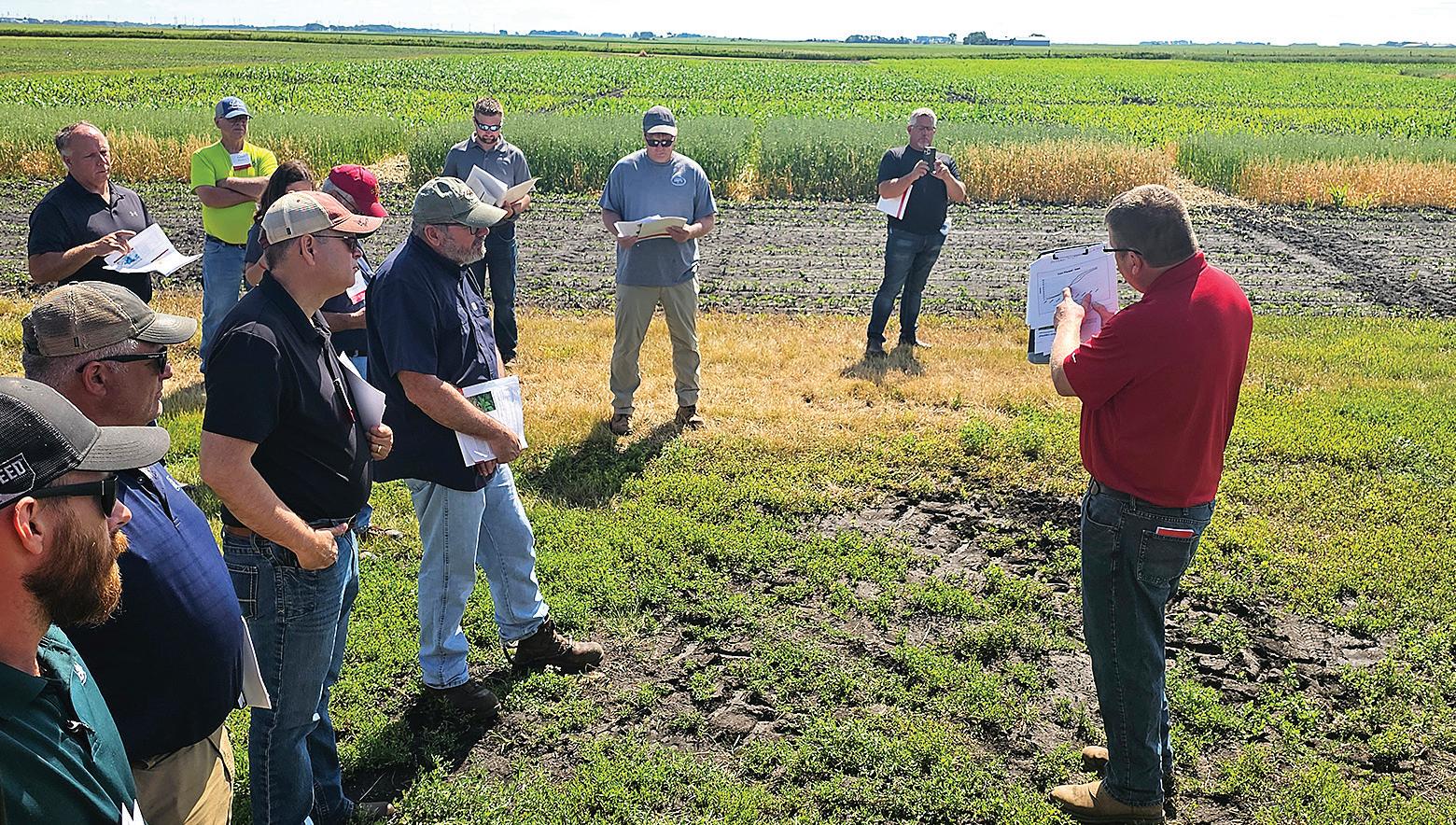
THE NORTHERN RESEARCH AND DEMONSTRATION FARM near Kanawha regularly hosts field days for farmers and other ag professionals. Gentry Sorenson (right), a field agronomist with Iowa State University Extension and Outreach, discussed weed management during a June 2024 field day at the farm.
TOP PHOTO: Located just south of Kanawha, the 173-acre Northern Research and Demonstration Farm regularly hosts field days in conjunction with Iowa State University Extension and Outreach. Extension specialists share the latest, science-based research on soybean and corn production, weed management and more.




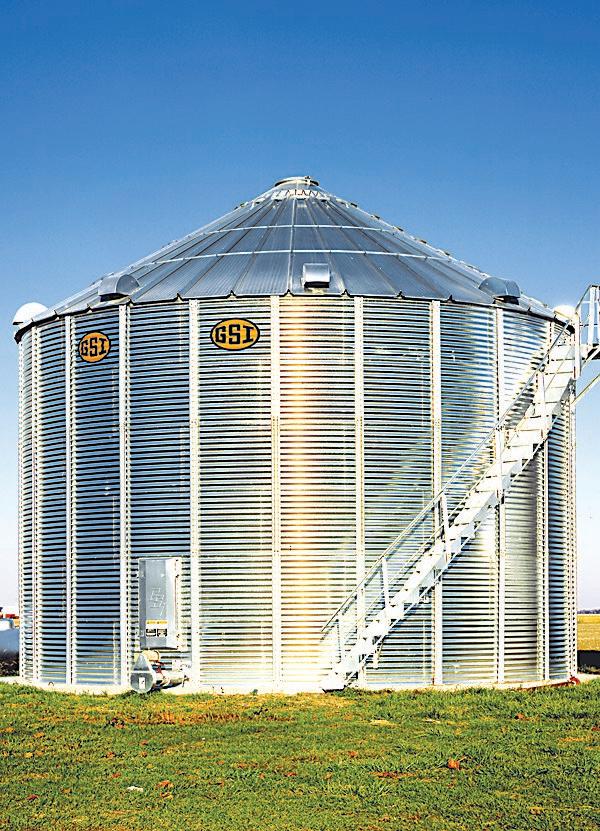



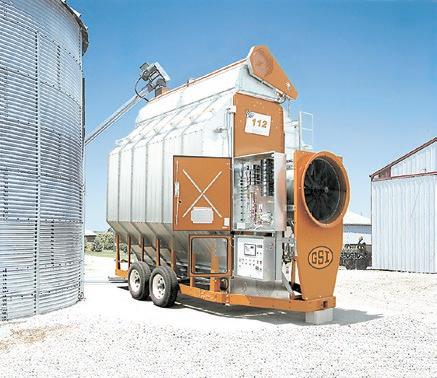







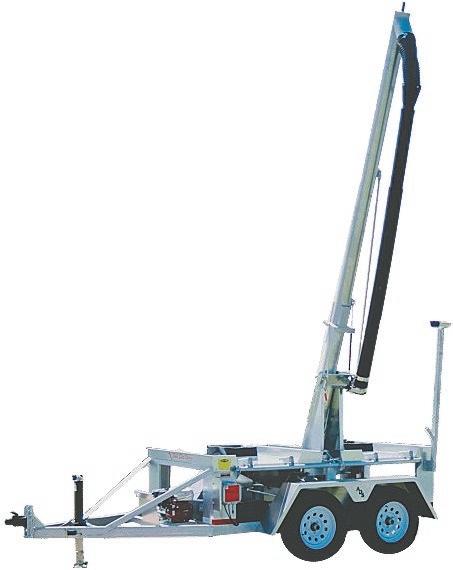

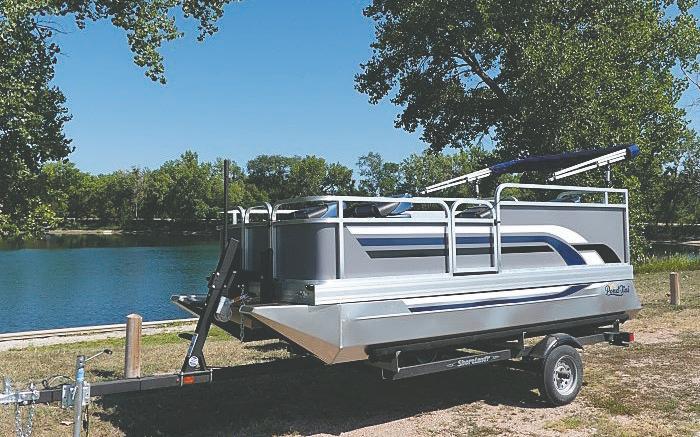
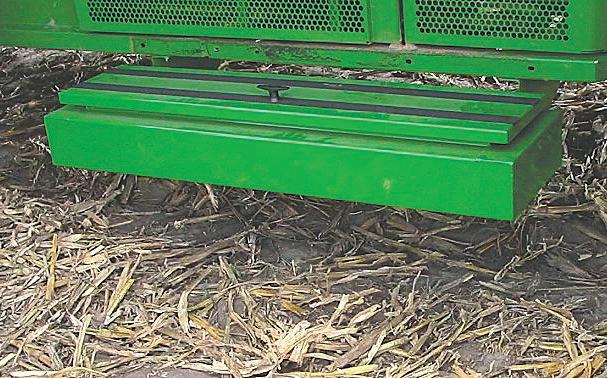















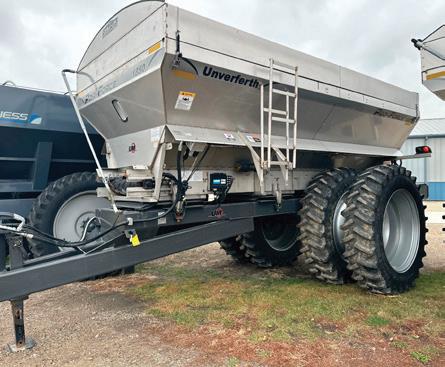
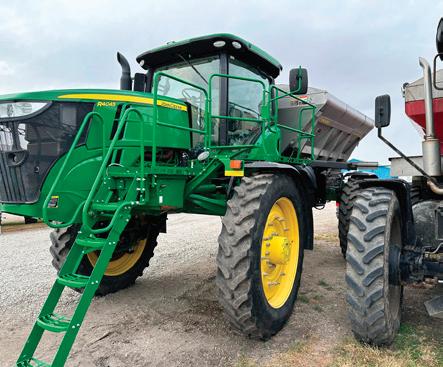
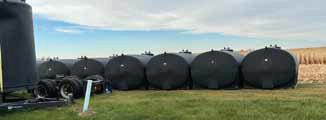




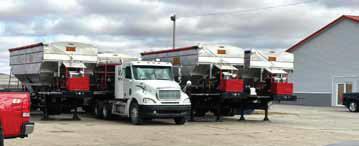
•

6-24-6, 9-18-9, 3-18-18
7-21-7, 4-10-10, 10-34-0, 7-18-6-25
•
7-18-6, 8-21-5, 4-13-17-15
•
•



longneckerfertilizers.com




gives farmers some optionality.
-Farm News photo by
Doug Clough
ERIK LIGHTNER, CEO of Platinum Crush near Alta, explains what products are processed at the company's plant, which opened in early May of this year. Lightner has a chemical engineering degree from Penn State and credits his background for making him a problem solver.


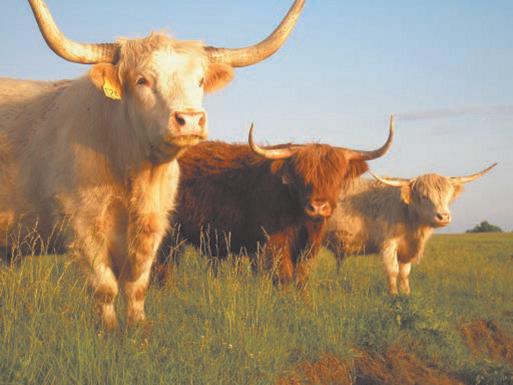

“Putting us as the processor right in the middle of the farmer’s growing region is a good thing for producers. In the 50-mile region we serve, this was primarily a net export environment; we want to have an impact by purchasing farmer-direct beans.”
In late August, Lightner sat down with his team for a preharvest meeting.
“We discussed how our staffing is going to look during harvest,” said Lightner. “Not just in how we receive the beans, but how we build the credibility and confidence of the local community; we are their best option financially, timewise, and in efficiency. The last thing we want is to not have trucks under combines because trucks are setting in a line.”
In pre-harvest times, Platinum Crush receives beans from 8 a.m.




to 4 p.m. During the approximate six-week harvest period, Lightner expects that time frame to expand to receive 400 to 500 trucks per day.
“We started receiving soybeans Sept. 25 of last year,” said Lightner. “We began bringing beans in again in March of this year. Since May, we’ve been bringing in grain daily.”
Lightner said that the company has developed a good local truck soybean market. Twentyfour soybean meal trucks were loaded in August, which was the company’s biggest day at that time. “The quality of our products, both in the soybean meal and soybean oil have far exceeded my expectations,” said Lightner. “It’s great to have capacity at 97% throughput, but our reputation in the market isn’t for the number of beans we crush, but the quality of the products that get sold.”




weed management and more.
The current capital campaign is spearheaded by the North Central Iowa Research Association (NCIRA), which owns the research farm. This nonprofit group includes nearly 70 farmers, ag businesses and landowners across northcentral Iowa. NCIRA is guided by a 19-member board of directors.
“We launched this capital campaign after we re-assessed the future of the research farm a few years ago,” said Greg Guenther, NCIRA president and northcentral Iowa farmer. “With the increased size of modern farm equipment and advances in digital agriculture, we felt a larger shop, large classroom and new office complex are important to help support the farm’s mission of sharing research results that help boost farm profitability.”
Fundraising is well underway, thanks to private and corporate donations. The capital campaign also received a big boost from the Lawyer family of Worth County. They have offered to match donations to the capital campaign up to
$50,000 by the end of 2024.
“Caryl Lawyer and her late husband, David Lawyer, have always been steadfast advocates of agriculture,” said Angie Rieck-Hinz, an ISU Extension field agronomist who serves north-central Iowa. “Their curiosity has led them to try many new things on their farm and foster their support of agricultural research and education. We appreciate their support of the Northern Research Farm.”
The Northern Research and Demonstration Farm is unique among the various research farms across Iowa. While ISU scientists have conducted research at facilities in and around Ames and central Iowa for decades, the Northern Research and Demonstration Farm is the oldest outlying research association in Iowa.
In the early 1930s, leaders of American Crystal Sugar approached Charles Curtiss, dean of Iowa State’s College of Agriculture and director of the
Iowa Agriculture and Home Economics Experiment Station, about the need for research on sugar beets to support farmers in northern Iowa.
The Kanawha Chamber of Commerce viewed this as an excellent opportunity, as well. Around 1931, local farmers and businessmen in north-central Iowa raised $12,000 to purchase 93 acres for an experimental farm. (That’s roughly the equivalent of $250,000 in 2024 dollars.)
With the support of 350 shareholders, the North Iowa Experimental Association was formed. Project leaders built a lab and machine shed at the farm. They also partnered with Iowa State to conduct research that would benefit local farmers, based on the local soils and weather conditions of northern Iowa.
As the research farm evolved, the Clarion-Webster Experimental Association was organized in 1946. By 1952, the group purchased 80 acres south of the original research farm to focus on drainage research.
In 1995, the two associations merged
and formed NCIRA, a nonprofit, 501(c) (3) organization. Through the years, the research farm at Kanawha has served as a model for other association-owned farms in Iowa, as well as similar research farms in other states and in countries around the world.
NCIRA continues its partnership with ISU to conduct relevant crop production, crop protection and water quality research to serve the farmers and agricultural retailers of northern Iowa. The association also partners with ISU Extension and Outreach to offer multiple field days, demonstrations and youth learning events each year.
“Many of ISU’s crop production recommendations for soybeans and small grains come from years of research conducted at this farm and other research farms throughout the state,” Rieck-Hinz said. “We appreciate this long-standing partnership with the Northern Research Farm.”
See FARM, Page 15C











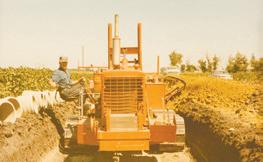



















By DARCY DOUGHERTY MAULSBY
News writer
SPENCER — When it comes to soybean production, most landowners and tenants ultimately want the same things — to maximize the productivity, profitability and sustainability of the land.
Reaching these goals isn’t always easy, though, especially as more landowners are far removed from the land.
“The landowner/land operator landscape has changed quite a bit through the years,” said Brent Swart, a Spencer-area farmer and Iowa Soybean Association (ISA) president-elect. “We have some fifth-generation land owners who have never farmed the land.”
It’s a misconception, however, that all these landowners only want to sell the land and get their money.
“Many of these landowners value their farm legacy and want to maintain it,” Swart said.
Swart and other northwest Iowa farmers discussed these topics during ISA’s “Strengthening Iowa’s Farms and Land Management Together” panel discussions at the 2024 Clay County Fair on Sept. 10. Panelists offered these 10 tips for better landowner/tenant communications and business relationships:
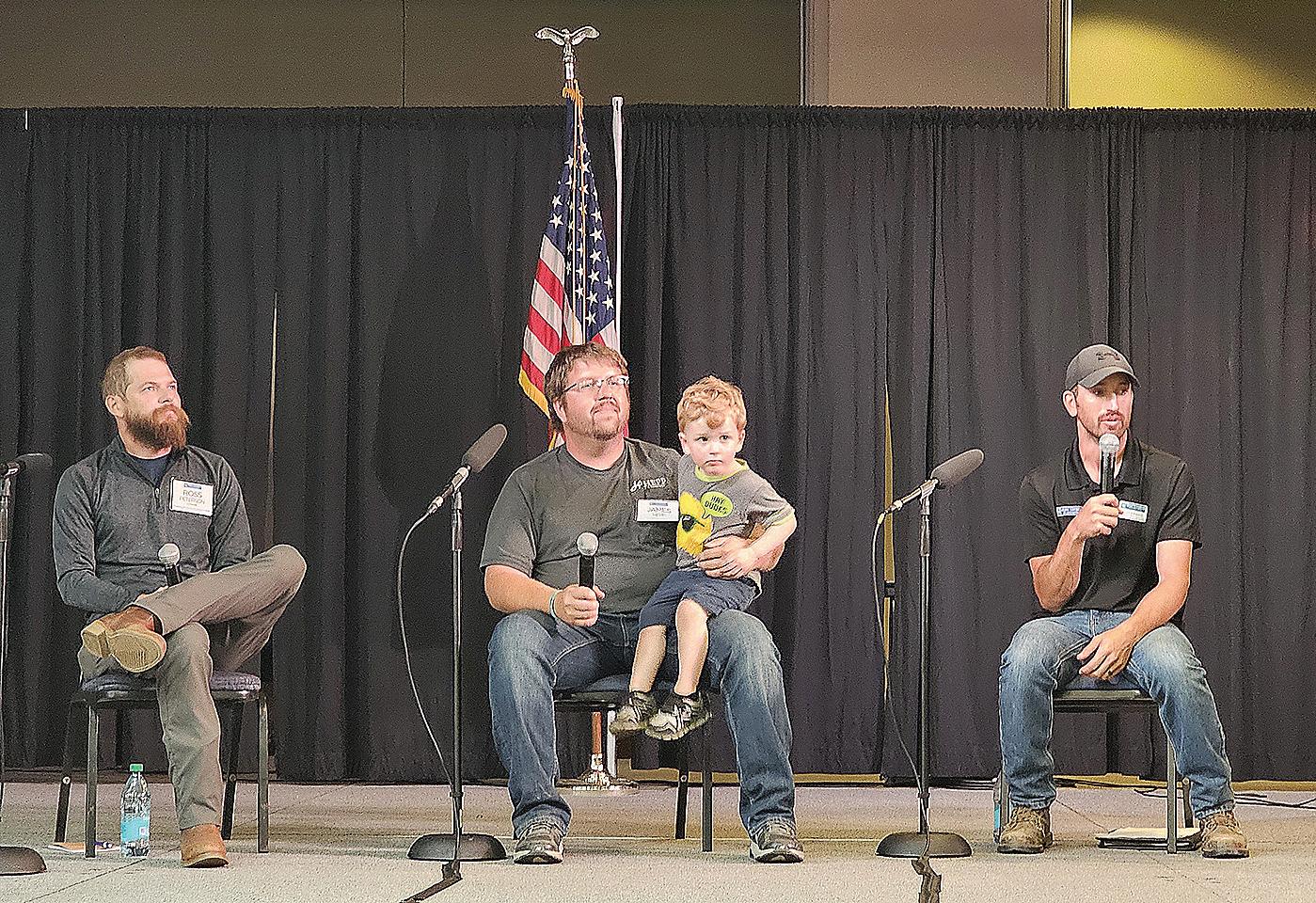
THE IOWA SOYBEAN ASSOCIATION (ISA) hosted the "Reaching Your ROI by Embracing Your Why — Together" panel discussion at the 2024 Clay County Fair on Sept. 10. Speakers included (left to right) Ross Peterson, who farms near Cleghorn; James Hepp (and his son Karsten), who farms near Rockwell City; and Ryan Johnson, a Cherokee-area farmer and Iowa Soybean Association (ISA) conservation agronomist.
1. Define what success looks like for both parties. The landowner needs to consider the perspective of the tenant, just as the tenant needs to consider the landowners’ needs. “What does success look like from each of these two different perspectives?” asked Chuck White, a Spencer-area farmer and former ISA district director. “Try to make sure both parties’ needs are met.”




2. Set clear expectations. As landlords and tenants work together, it’s wise to make sure expectations for both parties are clearly defined at the start of each year. Expectations that are specific and put in writing help build trust, which




builds stronger relationships. Also, have realistic expectations and timelines, said Patrick White, Chuck White’s son, who farms near Spencer. “Realize that there could be some challenges when you’re starting to use cover crops, for example. Start small, and learn how to manage cover crops properly. Once you successfully implement small changes, you can continue to expand your use of conservation practices each year.”
3. Value honesty and integrity. There’s a common concern that “the more transparent I am, the more the landlord can use this against me.” Don’t be fearful to share information, whether you’re the tenant or the landlord, Chuck White said. Focus on integrity. “This means doing the right thing for the land and the farm business,” Patrick White said. It requires ongoing communication. “If anything, it’s better to over communicate than under communicate,” Chuck White added.
4. Honor people’s communication preferences. How does the landlord prefer to be communicated with? Some prefer electronic communication (emails and text messages), while others like phone calls or postal mail. Also, take the time to send the landowner photos and videos periodically from their farm. “Communication is relationship building,” Chuck White said.
5. Take a systems approach to farm management. When adding conservation farming practices, don’t try to find one magic “silver bullet.” Instead, focus on








By KRISTIN DANLEY GREINER Farm News writer
The U.S. soybean yield for the 2024 growing season has been forecast at 53.2 bushels per acre, up 1.2 bushels per acre from last month’s trend-based yield of 52.0 bushels per acre, according to the USDA’s yield forecast released Aug. 14. With a higher yield anticipated, the markets have been responding accordingly, ag economists report.
Combined with a 1.0-million acre increase in the harvested area estimate, which now stands at 86.3 million acres, the soybean production forecast for marketing year 2024-2025 is increased by 154 million bushels to 4.6 billion bushels, the USDA report stated.
With a higher soybean supply, the U.S. soybean exports forecast is raised this month by 25 million bushels to 1.85 billion bushels and crush is unchanged at 2.4 billion bushels.
“We’ve been on a long downward slide and now we’re feeling around to see if we’ve hit bottom yet or not,” Iowa State University Extension Ag Economist Chad Hart said on Sept. 11. “When you look at November beans pricing at $10, you know it’s not near where it was near a year ago, but in the grand scheme of things, we’ve seen it worse. It’s one of these deals where we’ve seen a 20 percent drop in prices over the past year, so that’s a hard thing to swallow right now for a lot of producers. At the same time, too, there’s a lot of really good reasons we’ve seen such a price drop.”
There’s the potential of the crop being the biggest one ever seen this harvest, Hart pointed out, which is being seen not just in the U.S. but worldwide.

“Everyone has beans to sell and that helps drive prices down. It’s been a rough year and if you’re looking for positive influences out there for the market, we continue to see biofuel development through renewable diesel and soybean crush levels are really strong because of that,” said Hart. “If the USDA is correct on its prospect of export numbers, we’re looking to bounce back over the next 12 to 18 months. So demand is pretty good.”
As always, weather has played a role in the markets, but Hart noted that he’s
heard issues with the Mississippi River being too low.
“It’s a double-edged sword. We don’t want moisture during harvest, but we need it to help keep that river flowing down to the Gulf,” he said. “It’s amazing how quickly we went from too dry early and started the year worried about being too dry, then went to too wet then back to dry conditions. Overall, it’s been a really great year to produce great soybeans and a really rough year to market them.”
Grant Kimberley, senior director
of market development for the Iowa Soybean Association, said Sept. 12 that it would take a major production or demand catalyst beyond what would be expected at the moment to break out of the current market price ranges.
“The markets are going to start focusing on what yields already are forecast at and see if we achieve those pretty lofty expectations,” Kimberley said. “It’s turned out to be pretty dry at the end of the growing season, so that might have trimmed things a bit. We’ll also look at how export sales are trending, but China and other places are running behind the five-year average for export pre-sales leading into the year, so we’ll hope that picks up more than what it already has.”
With China the biggest whole bean buyer in the market now and for the foreseeable future, it was good news when growers heard that the forecast had been bumped a couple million metric tons higher from that country.
“It’s also hot and dry in South America. With La Nina occurring right now, that could delay their planting window or cause a shorter-term challenge by pushing them back later for harvest. That helps us expand our export marketing windows a little later into the winter,” Kimberley said.
He said that export sales need to bump up higher and meal exports need to start increasing, since there will be more crush capacity coming online.
“That’s important as the biofuel demand is important, too, of course, but I’ve heard in California there will be a cap for soybean oil,” he said. “Those are more longer-term challenges as our short-term issues to watch are more our weather, South America’s weather and export sales.”
712-848-3443
Bob Wagner 712-358-1312
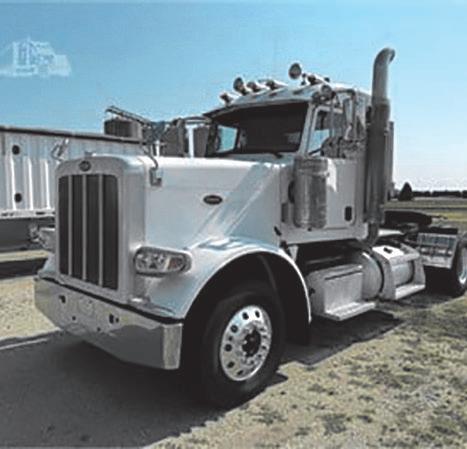




















Through the years, the Northern Research Farm has benefited area communities not only through farm research, but by donating hundreds of pounds of freshly grown vegetables to the local nursing home, providing pumpkins for school kids and supporting local community events.
This commitment resonates with the Lawyer family, who issued the challenge grant to help support the capital campaign. Ag innovation has long been a part of Caryl Lawyer’s family heritage.
“My dad was an agricultural engineer, and my husband’s family grew hemp for rope-making in World War II,” she said. “They also grew soybeans, and my father-in-law was president of the North Iowa Soybean Cooperative in the 1940s.”
The family also grew sugar beets in the 1960s. Lawyer credits her family’s
ag background for the work ethic, dedication and trust that have kept their family strong through the generations.
“It’s human nature to create challenges, so we created a challenge for others to join us to improve this north Iowa facility for top-notch research,” she said.
Guenther appreciates this support and encourages local farmers, landowners, ag businesses and others to invest in the future of the research farm. Contributions to the capital campaign can be sent to North Central Iowa Research Association, 310 S. Main St., Kanawha, IA, 50447.
To make a gift of grain this fall as a donation to the campaign, contact Matt Schnabel, farm superintendent, at mschn@iastate.edu.
“The generosity of the Lawyer family is a great opportunity,” Guenther said. “People can double their support by helping us meet this challenge.”
“The generosity of the Lawyer family is a great opportunity. People can double their support by helping us meet this challenge.”
NCIRA president and north-central Iowa farmer






















understanding the complex relationships between interconnected elements, including soil health and the beneficial microbes that impact fertility, drainage and more. This is a systems approach, where the right management practices work together to create something greater than the sum of the individual parts.
“With a systems approach, sometimes 2 + 2 = 6,” said James Hepp, who farms near Rockwell City and participated in ISA’s “Reaching Your ROI by Embracing Your Why — Together” panel at the Clay County Fair. For Hepp, this meant using 100 to 120 pounds of nitrogen per acre and reallocating his fertilizer budget to including in-season, Y-DROP sidedressing to produce 220-bushel corn.
6. Keep learning. There is a learning curve when it comes to successfully integrating conservation farming practices, from no-till to cover crops. “Learn from people who are successfully using these conservation practices in your area,” said Chuck White, who has been no-tilling soybeans for more than 20
years and has used cover crops since 2013. The right attitude is also key, he added. “If you believe a conservation ag practice isn’t going to work, it won’t, but if you believe it will work, it will.”
7. Go on offense to lower the cost of production. As weaker commodity prices force farmers’ hands, conservation farming practices like reduced tillage or no-till can pay off. “They can help you lower your cost of production to get through these leaner times,” Swart said. “Conservation is a solution, not a problem.”
8. Never stop asking why. Part of good communication between landowners and tenants means running the numbers. Get out the calculator, and look for ways you can make more money, trim costs and reallocate resources for a better return on investment (ROI). Also, don’t be afraid to question conventional wisdom. The right mentors can be a tremendous help in this respect. “There’s no need to reinvent the wheel,” said Hepp, who’s a big proponent of Xtremeag.farm, where


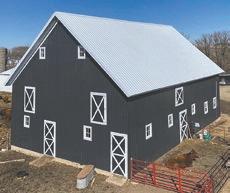

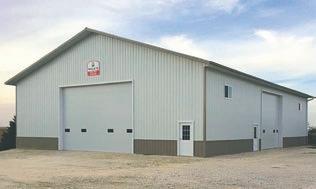


members get farming expertise from top growers to build sustainable farming practices, improve ROI, enhance crop yields and increase farm profitability. “Successful businesses have a research and development (R&D) department,” Hepp added. “Be willing to try new things, and be willing to change when you see there’s a better way. If you can’t afford to try something on 5 or 10 acres, you’re already broke.”
9. Stay focused. Avoid the naysayers. “There can be a lot of peer pressure in farming,” Hepp said. “As a firstgeneration farmer, I look at things differently. Remember that iron sharpens iron.”
10. Work together. A successful working relationship between landowners and tenants comes down to transparency, trust and trying new things together.
“‘Together’ is the key word,” said Jennifer Simpson with Simpson Sales Solutions, who moderated one of the sessions at the ISA meeting. “That’s how you grow a farm’s productivity, profitability and

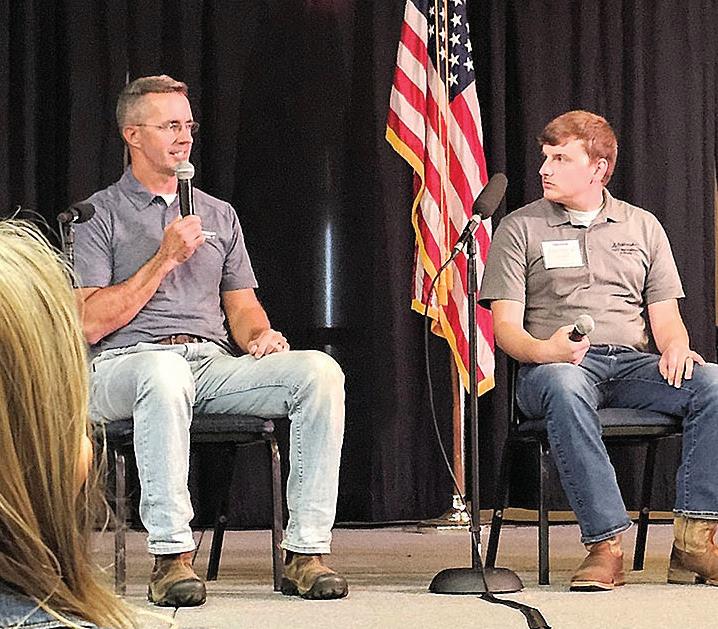
THE LANDOWNER/LAND OPERATOR LANDSCAPE has changed quite a bit through the years, says Brent Swart (left), a Spencer-area farmer and Iowa Soybean Association president-elect. On Sept. 10, he participated in a panel discussion "Beyond the Handshake: How to Improve Land Management by Strengthening Your Roles Through Communication" at the Clay County Fair. Swart was joined by Patrick White (right) and his father, Chuck White, (not pictured) who both farm in the Spencer area.


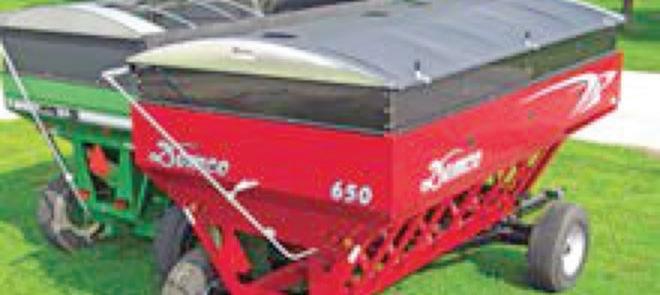

















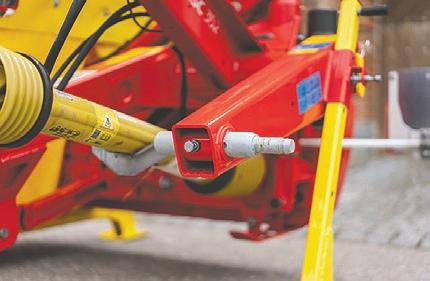












Compare hundreds of the Latest & Best Equipment, Solutions and Ideas – All Under One Roof! In the Center of Farm Country!

Since 1967, the Triumph of Ag Expo has been regarded as one of the finest indoor farm shows. Join us for your opportunity before spring planting to save time and money, improve operations, yields, safety, efficiency and find the latest solutions - This is your Market! Join us at the area’s largest indoor short-line Farm & Ranch Machinery Show!

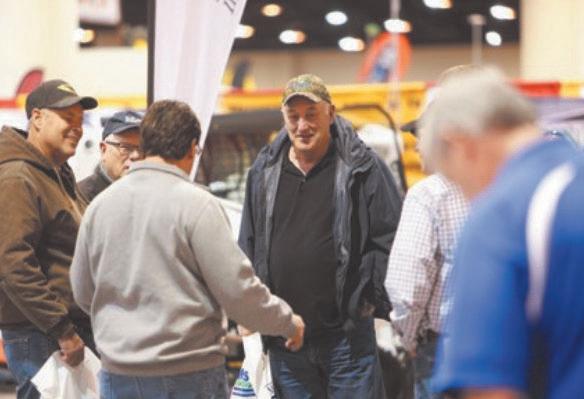

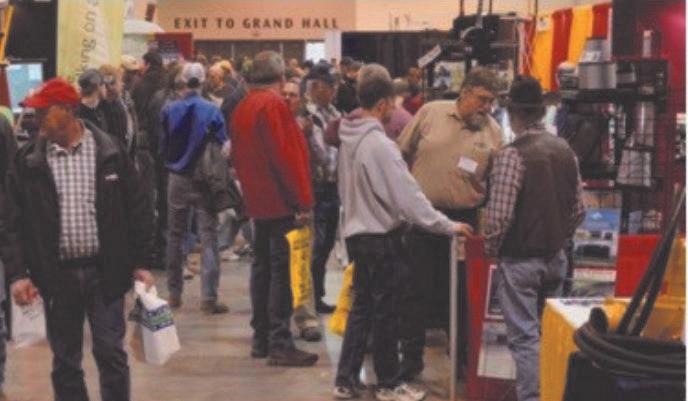






LOADERS / BACKHOES / SKID-LOADERS / COMPACT LOADERS / TRACTOR / TELEHANDLERS













“UBI has great service - they are helpful, easy to work with, and always go the extra mile. I appreciate that UBI helps with forward marketing, running numbers, and discussing my cash flow with me. I tell everyone to bank at UBI and see Andy for all of your banking.”
- Ivan Kiner (pictured with UBI lender Andy Hunziker)





Ida Grove • Alta
Anthon • Arthur • Aurelia
Boone



Carroll • Charter Oak Churdan • Cleghorn • Cushing • Denison


Fort Dodge • Galva Glidden • Harlan
Holstein
Moorhead
Moville
Odebolt • Onawa • Pierson Pocahontas • Rockwell City • Rolfe
Sac City • Schleswig
Storm Lake








